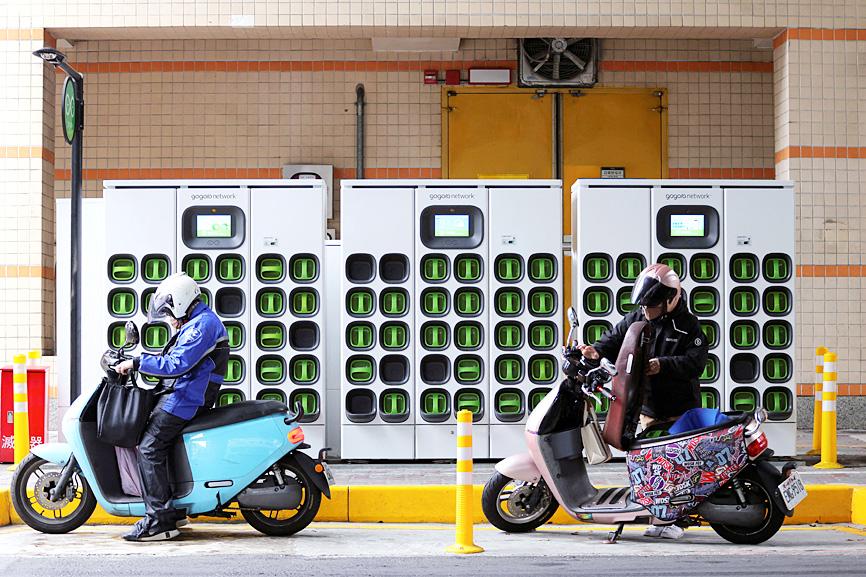Electric scooter maker Gogoro Inc (睿能創意) has all the chips it needs for now, but could face a squeeze by year-end as it pushes big plans to grow in China, India and Southeast Asia, founder and chief executive Horace Luke (陸學森) said yesterday.
While a global shortage of semiconductors has slammed auto makers, Luke said in an interview that Gogoro, which listed in New York this month, uses far fewer chips than electric automakers and still has a relatively small market concentrated in Taiwan.
For the next several months it has a “healthy supply” of chips, he said.

Photo: Annabelle Chih, Reuters
“A combination of we don’t use as many, a combination of being flexible on our design, a combination of having a market that is not yet gigantic at the moment,” Luke said, explaining Gogoro’s chips situation.
Founded in 2011, Gogoro listed on the NASDAQ via a merger with blank-check firm Poema Global Holdings Corp and has a market value of about US$2.4 billion.
The firm has ambitious plans for China, India and Southeast Asia, seeing potential in replacing vast fleets of heavily polluting, gasoline-powered scooters with electric two-wheelers as Asia’s metropolises bid to improve air quality.
“As those cities like Jakarta, or Delhi, or other big markets grow, how fast they grow of course will then put stress on our supply chain management, but those are problems that are coming in the later part of the year, not the immediate future,” Luke said.
As well as making its own vehicles, Gogoro has electric battery and other partnerships with vehicle makers, including India’s Hero MotoCorp Ltd, and China’s Dachangjiang Group Co (大江集團) and Yadea Group Holdings Ltd (雅迪集團控股).
Gogoro, known for its green-hued battery swap distribution network for riders, generates about 90 percent of its revenue from Taiwan.
Electric vehicle makers have been hit by price hikes for raw materials such as nickel, driven by supply chain disruptions from the war in Ukraine, and Luke said some “minor” price rises had been passed onto customers.
Gogoro’s stock has dropped about 19 percent since listing, matching pressure on other tech plays globally.
However, Luke said Gogoro was confident in expansion plans in countries like China, India and Indonesia, which have a high consumer preference for scooters, with millions sold each year.
“That’s what our investors, our team, is focused on, and that’s what our partnerships are focused on, to take our technology which we’ve created and go into those large markets that have high potential to convert to electric,” he said.

Shares in Taiwan closed at a new high yesterday, the first trading day of the new year, as contract chipmaker Taiwan Semiconductor Manufacturing Co (TSMC, 台積電) continued to break records amid an artificial intelligence (AI) boom, dealers said. The TAIEX closed up 386.21 points, or 1.33 percent, at 29,349.81, with turnover totaling NT$648.844 billion (US$20.65 billion). “Judging from a stronger Taiwan dollar against the US dollar, I think foreign institutional investors returned from the holidays and brought funds into the local market,” Concord Securities Co (康和證券) analyst Kerry Huang (黃志祺) said. “Foreign investors just rebuilt their positions with TSMC as their top target,

REVENUE PERFORMANCE: Cloud and network products, and electronic components saw strong increases, while smart consumer electronics and computing products fell Hon Hai Precision Industry Co (鴻海精密) yesterday posted 26.51 percent quarterly growth in revenue for last quarter to NT$2.6 trillion (US$82.44 billion), the strongest on record for the period and above expectations, but the company forecast a slight revenue dip this quarter due to seasonal factors. On an annual basis, revenue last quarter grew 22.07 percent, the company said. Analysts on average estimated about NT$2.4 trillion increase. Hon Hai, which assembles servers for Nvidia Corp and iPhones for Apple Inc, is expanding its capacity in the US, adding artificial intelligence (AI) server production in Wisconsin and Texas, where it operates established campuses. This

H200 CHIPS: A source said that Nvidia has asked the Taiwanese company to begin production of additional chips and work is expected to start in the second quarter Nvidia Corp is scrambling to meet demand for its H200 artificial intelligence (AI) chips from Chinese technology companies and has approached contract manufacturer Taiwan Semiconductor Manufacturing Co (TSMC, 台積電) to ramp up production, sources said. Chinese technology companies have placed orders for more than 2 million H200 chips for this year, while Nvidia holds just 700,000 units in stock, two of the people said. The exact additional volume Nvidia intends to order from TSMC remains unclear, they said. A third source said that Nvidia has asked TSMC to begin production of the additional chips and work is expected to start in the second

US President Donald Trump on Friday blocked US photonics firm HieFo Corp’s US$3 million acquisition of assets in New Jersey-based aerospace and defense specialist Emcore Corp, citing national security and China-related concerns. In an order released by the White House, Trump said HieFo was “controlled by a citizen of the People’s Republic of China” and that its 2024 acquisition of Emcore’s businesses led the US president to believe that it might “take action that threatens to impair the national security of the United States.” The order did not name the person or detail Trump’s concerns. “The Transaction is hereby prohibited,”